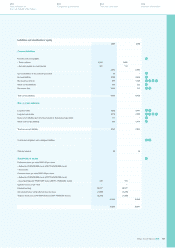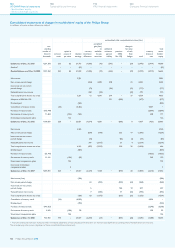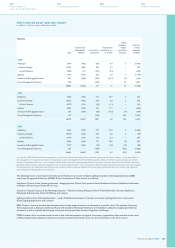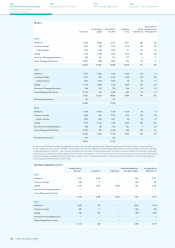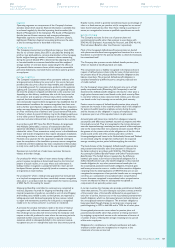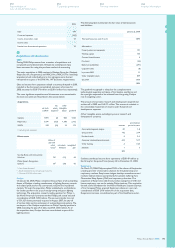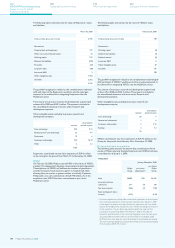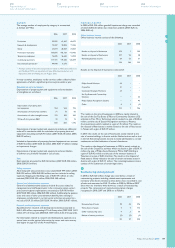Philips 2008 Annual Report Download - page 139
Download and view the complete annual report
Please find page 139 of the 2008 Philips annual report below. You can navigate through the pages in the report by either clicking on the pages listed below, or by using the keyword search tool below to find specific information within the annual report.
Non-derivative financial instruments
Non-derivative financial instruments are recognized initially at cost
or fair value. Financial assets transferred to another party are
derecognized to the extent that the Company surrenders control
over those assets in exchange for a consideration other than
beneficial exchange for interest in the transferred assets. Financial
liabilities are derecognized if and only if they are extinguished.
Non-derivative financial instruments are accounted for as a sale to
the extent that a consideration other than beneficial interests in the
transferred assets is received in exchange. The Company has
surrendered control over transferred assets if and only if: (i) the
transferred assets have been isolated from the Company beyond its
reach and its creditor even in bankruptcy or other receivership, (ii)
the transferree has the right to pledge or exchange the assets it
received, and no condition both constrains the transferee from taking
advantage of its right to pledge or exchange and provides more than
a trivial benefit to the Company, and (iii) the Company does not
maintain effective control over the transferred assets.
Regular way purchases and sales of financial instruments are accounted
for at trade date, i.e., the date that the Company commits itself to
purchase or sell the instrument. Dividend and interest income are
recognized when earned. Gains or losses, if any, are recorded in
financial income and expenses.
Cash and cash equivalents
Cash and cash equivalents include all cash balances and short-term
highly liquid investments with an original maturity of three months
or less that are readily convertible into cash. They are stated at face
value, which approximates their fair value.
Receivables
Trade accounts receivable are carried at face value, net of allowances
for doubtful accounts. As soon as trade accounts receivable can no
longer be collected in the normal way and are expected to result in
a loss, they are designated as doubtful trade accounts receivable and
valued at the expected collectible amounts. They are written off when
they are deemed to be uncollectible due to bankruptcy or other forms
of receivership of the debtors.
The allowance for the risk of non-collection of trade accounts receivable
takes into account credit-risk concentration, collective debt risk based
on average historical losses and specific circumstances such as serious
adverse economic conditions in a specific country or region.
In the events of sale of receivables and factoring, the Company
derecognizes the receivables and accounts for them as a sale only
to the extent that the Company has surrended control over the
receivables in exchange for a consideration other than beneficial
interest in the transferred receivables.
Long-term receivables are initially recognized at their net present
value using an appropriate interest rate. Any discount is amortized
to income over the life of the receivable using the effective yield.
Debt and other liabilities
Debt and liabilities other than provisions are stated at amortized
cost. However, loans that are hedged under a fair value hedge are
remeasured for the changes in the fair value that are attributable
to the risk that is being hedged.
Investments in equity-accounted investees
Investments in companies in which the Company does not have the
ability to directly or indirectly control the financial and operating
decisions, but does possess the ability to exercise significant influence,
are accounted for using the equity method. In the absence of
demonstrable proof of significant influence, it is presumed to exist
if at least 20% of the voting stock is owned. The Company’s share of
the net income of these companies is included in results relating to
equity-accounted investees in the Consolidated statements of income.
When the Company’s share of losses exceeds the carrying amount of
an investment accounted for by the equity method, the Company’s
carrying amount of that investment is reduced to zero and recognition
of further losses is discontinued unless the Company has guaranteed
obligations of the investee or is otherwise committed to provide
further financial support to the investee.
Investments in equity-accounted investees include goodwill and loans
from the Company to these investees.
Accounting for capital transactions of a consolidated subsidiary
or an equity-accounted investee
The Company recognizes dilution gains or losses arising from the
sale or issuance of stock by a consolidated subsidiary or an equity-
accounted investee in the income statement, unless the Company
or the subsidiary either has reacquired or has plans to reacquire
such shares. In such instances, the result of the transaction will be
recorded directly in stockholders’ equity.
The dilution gains or losses are presented on a separate line in the
consolidated statement of income if they relate to consolidated
subsidiaries. Dilution gains and losses related to equity-accounted
investees are presented under “Results relating to equity-accounted
investees” in the consolidated statements of income.
Other non-current financial assets
Other non-current financial assets include available-for-sale securities,
held-to-maturity securities, loans and cost-method investments.
The Company classifies its investments in equity securities that have
readily determinable fair values as either available-for-sale or for
trading purposes. Trading securities acquired and held principally for
the purpose of selling them in the short term are presented as ‘Other
current assets’. Trading securities are recorded at fair value; changes
in the fair value are recognized as financial income and expense. All
securities not included in trading or held-to-maturity are classified
as available-for-sale. Available-for-sale equity securities are recorded
at fair value; changes in the fair value are recognized in other
comprehensive income in stockholders’ equity. Unrealized holding
gains and losses, net of the related tax effect, on available-for-sale
securities are reported as a separate component of other
comprehensive income within stockholders’ equity until realized.
Realized gains and losses from the sale of available-for-sale securities
are determined on a first-in, first-out basis. For available-for-sale
securities hedged under a fair value hedge, the changes in the fair
value that are attributable to the risk which is being hedged are
recognized in earnings rather than in other comprehensive income.
Held-to-maturity securities are those debt securities which the
Company has the ability and intent to hold until maturity. Held-to-
maturity debt securities are recorded at amortized cost, adjusted
for the accretion of discounts or amortization of premiums using
the effective interest method.
Loans receivable are stated at amortized cost, less the related
allowance for impaired loans receivable.
Investments in privately-held companies are carried at cost, or
estimated fair value, if an other-than-temporary decline in value
has occurred.
Dividend and interest income are recognized when earned. Gains
or losses, if any, are recorded in financial income and expenses.
Impairments of financial assets
A financial asset is considered to be impaired if objective evidence
indicates that one or more events have had a negative effect on the
estimated future cash flows of that asset. The Company assesses its
long-term investments accounted for as available-for-sale on a quarterly
basis to determine whether declines in market value below cost are
other-than-temporary, the cost basis for the individual security is
reduced and a loss is realized in the period in which it occurs. When
the decline is determined to be temporary, the unrealized losses are
included in other comprehensive income.
If objective evidence indicates that cost-method investments needs
to be tested for impairment, calculation was based on unobservable
inputs which include certain pricing models, discounted cash flows
methodologies and similar techniques that use significant
unobservable inputs.
Philips Annual Report 2008 139
254
Corporate governance
250
Reconciliation of
non-US GAAP information
262
Ten-year overview
266
Investor information


